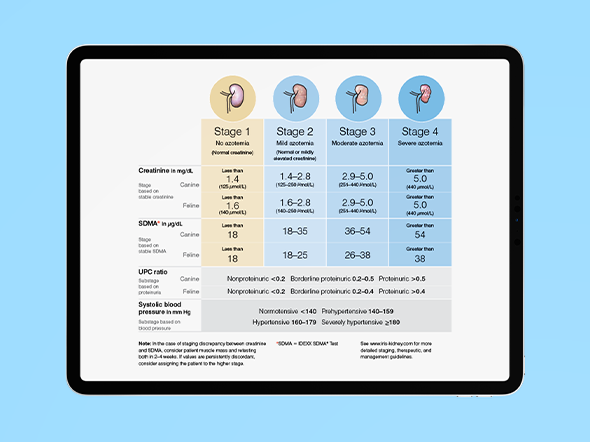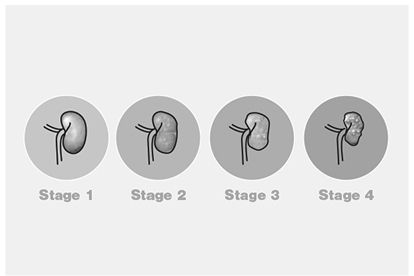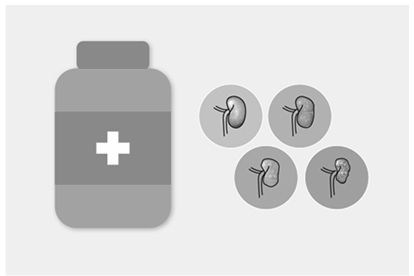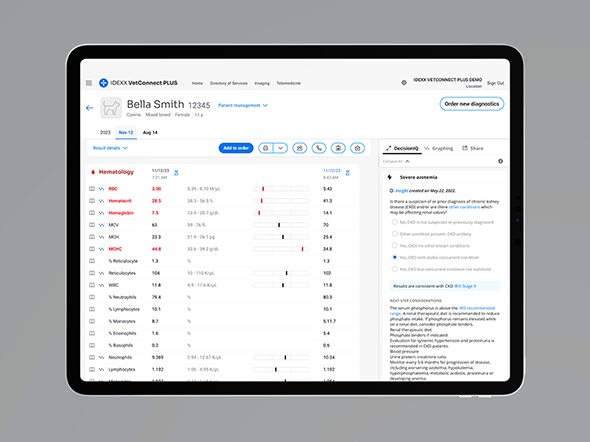
IRIS CKD guidelines for cats and dogs.
Chronic kidney disease: from detection to treatment and everything in between.
Learn more about using the International Renal Interest Society (IRIS) guidelines for staging and treatment of chronic kidney disease (CKD), while discovering the value of SDMA in diagnosing CKD earlier than ever before. Diagnose with more confidence and determine the most effective treatment options for all stages of CKD.


Step 1: Diagnose CKD.
This informative graphic walks you through the steps to diagnose CKD. Learn how IDEXX SDMA testing is import to include when diagnosing CKD, especially in cats or dogs with earlier or more advanced stages of the disease.1–5

Step 2: Stage CKD.
IRIS guidelines recommend treatment based on the stage of CKD. Learn more about the IRIS CKD Staging Guidelines and the value that SDMA adds to ensuring pets are treated for the most appropriate stage.

Step 3: Treat CKD.
This graphic provides an overview of the IRIS treatment recommendations for all stages of CKD, including early stages. It also shows how SDMA can impact treatment of later stages of CKD.

Stage CKD patients 8x faster on average.6
It’s never been easier to move from diagnosis to treatment.
- Simply view your results in VetConnect PLUS. If a patient is flagged to be evaluated for CKD, you’ll see a few simple questions pop up alongside the results.
- Just follow the prompts for next steps and recommendations.
Ready to access this great feature?
First-time user?
Activate your VetConnect PLUS account by calling 1-800-667-3411.
Learn more about the comprehensive kidney care diagnostics and support available from IDEXX.
Note: SDMA is symmetric dimethylarginine.
References
- Nabity MB, Lees GE, Boggess M, et al. Symmetric dimethylarginine assay validation, stability, and evaluation as a marker for early detection of chronic kidney disease in dogs. J Vet Intern Med. 2015;29(4):1036–1044 doi:10.1111/jvim.12835
- Hall JA, Yerramilli M, Obare E, Yerramilli M, Jewell DE. Comparison of serum concentrations of symmetric dimethylarginine and creatinine as kidney function biomarkers in cats with chronic kidney disease. J Vet Intern Med. 2014;28(6):1676–1683 doi:10.1111/jvim.12445
- Hall JA, Yerramilli M, Obare E, Yerramilli M, Almes K, Jewell DE. Serum concentrations of symmetric dimethylarginine and creatinine in dogs with naturally occurring chronic kidney disease. J Vet Intern Med. 2016;30(3):794–802 doi:10.1111/jvim.13942
- Hall JA, Yerramilli M, Obare E, Yerramilli M, Yu S, Jewell DE. Comparison of serum concentrations of symmetric dimethylarginine and creatinine as kidney function biomarkers in healthy geriatric cats fed reduced protein foods enriched with fish oil, L-carnitine, and medium-chain triglycerides. Vet J. 2014;202(3):588–596 doi:10.1016/j.tvjl.2014.10.021
- Hall JA, Yerramilli M, Obare E, Yerramilli M, Melendez LD, Jewell DE. Relationship between lean body mass and serum renal biomarkers in healthy dogs. J Vet Intern Med. 2015;29(3):808–814 doi:10.1111/jvim.12607
- Data on file at IDEXX Laboratories, Inc. Westbrook, Maine USA: Individual results will vary based upon each patient’s case complexity and practitioner’s CKD staging experience.